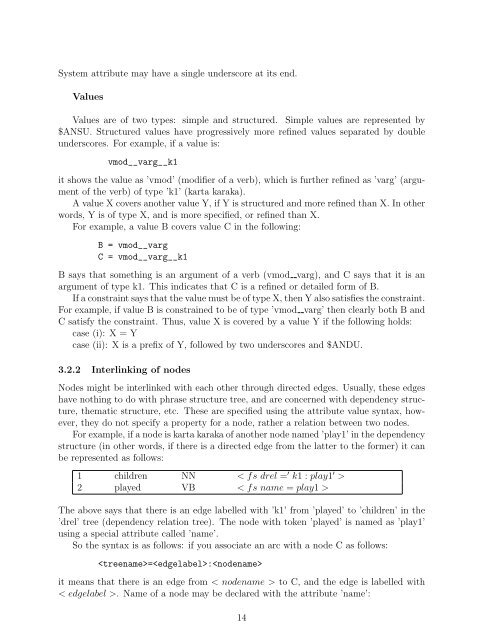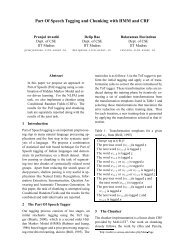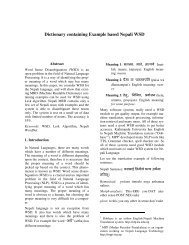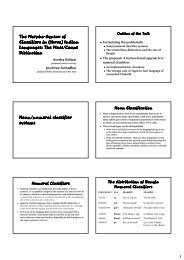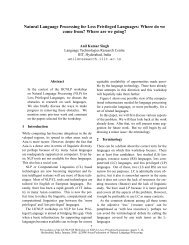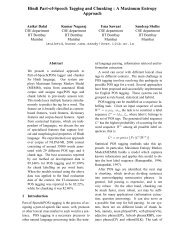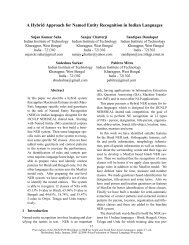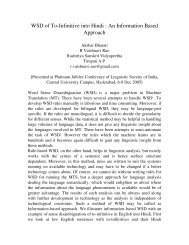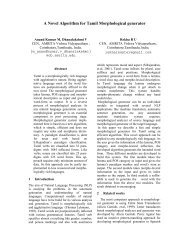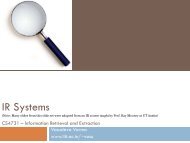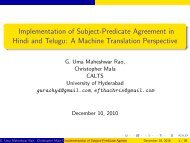SSF Format Doc - LTRC Home - IIIT Hyderabad
SSF Format Doc - LTRC Home - IIIT Hyderabad
SSF Format Doc - LTRC Home - IIIT Hyderabad
You also want an ePaper? Increase the reach of your titles
YUMPU automatically turns print PDFs into web optimized ePapers that Google loves.
System attribute may have a single underscore at its end.<br />
Values<br />
Values are of two types: simple and structured. Simple values are represented by<br />
$ANSU. Structured values have progressively more refined values separated by double<br />
underscores. For example, if a value is:<br />
vmod__varg__k1<br />
it shows the value as ’vmod’ (modifier of a verb), which is further refined as ’varg’ (argument<br />
of the verb) of type ’k1’ (karta karaka).<br />
A value X covers another value Y, if Y is structured and more refined than X. In other<br />
words, Y is of type X, and is more specified, or refined than X.<br />
For example, a value B covers value C in the following:<br />
B = vmod__varg<br />
C = vmod__varg__k1<br />
B says that something is an argument of a verb (vmod varg), and C says that it is an<br />
argument of type k1. This indicates that C is a refined or detailed form of B.<br />
If a constraint says that the value must be of type X, then Y also satisfies the constraint.<br />
For example, if value B is constrained to be of type ’vmod varg’ then clearly both B and<br />
C satisfy the constraint. Thus, value X is covered by a value Y if the following holds:<br />
case (i): X = Y<br />
case (ii): X is a prefix of Y, followed by two underscores and $ANDU.<br />
3.2.2 Interlinking of nodes<br />
Nodes might be interlinked with each other through directed edges. Usually, these edges<br />
have nothing to do with phrase structure tree, and are concerned with dependency structure,<br />
thematic structure, etc. These are specified using the attribute value syntax, however,<br />
they do not specify a property for a node, rather a relation between two nodes.<br />
For example, if a node is karta karaka of another node named ’play1’ in the dependency<br />
structure (in other words, if there is a directed edge from the latter to the former) it can<br />
be represented as follows:<br />
1 children NN < fs drel = ′ k1 : play1 ′ ><br />
2 played VB < fs name = play1 ><br />
The above says that there is an edge labelled with ’k1’ from ’played’ to ’children’ in the<br />
’drel’ tree (dependency relation tree). The node with token ’played’ is named as ’play1’<br />
using a special attribute called ’name’.<br />
So the syntax is as follows: if you associate an arc with a node C as follows:<br />
=:<br />
it means that there is an edge from < nodename > to C, and the edge is labelled with<br />
< edgelabel >. Name of a node may be declared with the attribute ’name’:<br />
14


